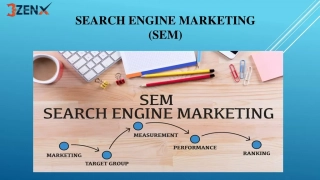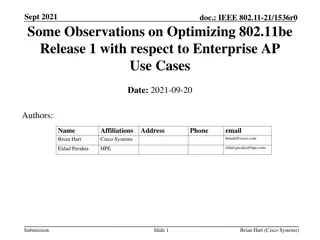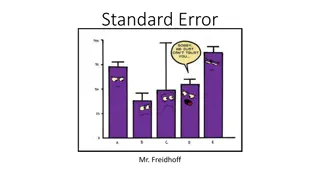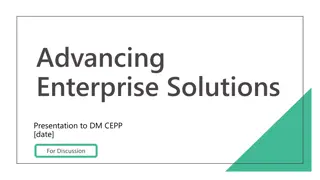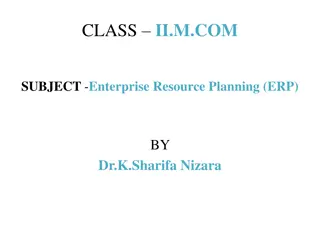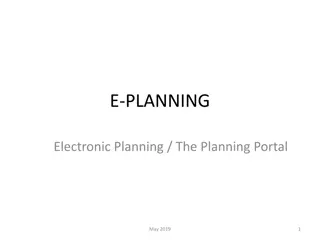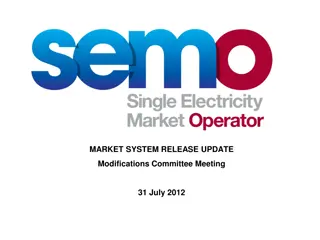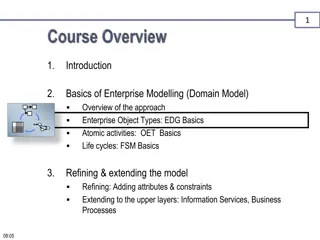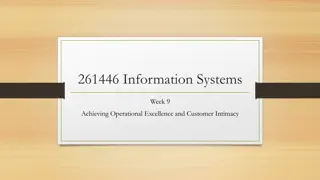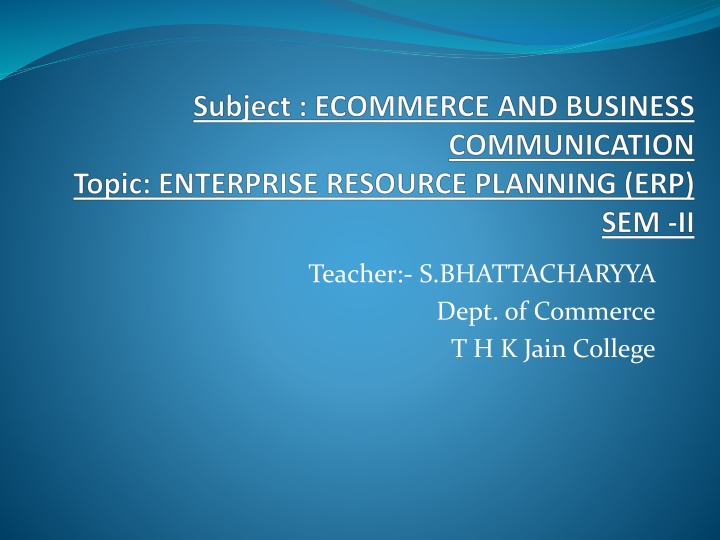
ERP Systems and Their Benefits
Learn about ERP systems, their integration within organizations, benefits such as efficiency and cost reduction, features like data exchange with stakeholders, and utilities like modular design and web enablement.
Download Presentation

Please find below an Image/Link to download the presentation.
The content on the website is provided AS IS for your information and personal use only. It may not be sold, licensed, or shared on other websites without obtaining consent from the author. If you encounter any issues during the download, it is possible that the publisher has removed the file from their server.
You are allowed to download the files provided on this website for personal or commercial use, subject to the condition that they are used lawfully. All files are the property of their respective owners.
The content on the website is provided AS IS for your information and personal use only. It may not be sold, licensed, or shared on other websites without obtaining consent from the author.
E N D
Presentation Transcript
Teacher:- S.BHATTACHARYYA Dept. of Commerce T H K Jain College
ERP definitions ERP is the Process of Integrating And Managing All the Business Functions Within the Organisations And to Exchange Information with the Outside Stake Holder (that is) Suppliers, Consumers, And Various Intermediaries It Integrates And Managed Financial Cost Accounting, Sales And Distributions, Material Management, Management, Production, Planning Marketing Management, Supply Chain Management. Human Resource
Features of ERP Integrating And managing All the Business Functions Within the Organisation Provides Competitive Advantages And Creates Value Through ERP Functions Enhance Speed And Efficiency of Operations Through Highest Level of the Customer Services , Improvement in Productivity, Decline in Cost, Increase Inventory Turnover Ratio Integration of Data in to Common Database for the Functional Development With the Help of Information Technology
Features of ERP (Continued) Exchanges Information With the Outside Stakeholders It Creates Departmental Harnomisation Through Integration And sharing Information by the Functional Department It Integrates Different Sub Systems (that is) Knowledge Base Systems, Decision Support System It Facilitates Quick flow of Information Regarding Various Departments Quick Accessible information Round the Clock basis
ERP Utilities Modular Design: It Incorporates Distinct Business Modules Such As Manufacturing, Financial, Accounting And Distributions. Central Common Database: All the Data Entered And Stored Once Used By the Various Departments. Best Business Practices: The Best ERP Systems Offers Best Business Practices Throughout Organisations. the World Wide Integration: The Best ERP Systems Supports Connectivity to Other Business Entities In the Organisations.
ERP Utilities (Continued) Flexibility: It Is Flexible to the Extent the Needs And Wants of the Enterprise. Compressive: It is Suitable for Wide Range of Business Organisation Web Enabled: It is Internet Or the Web based Applications Automatic Function: All the Financial And the Business Information Is Generated Automatically from the Data Entered in the Centralised Database
Benefits of ERP Competitive Advantages And Create Value Decline in Operating Cost By the Lowering Inventory Turnover cost And the Production Cost Improved Visibility Because of Centralised Function of ERP Easy Access to Data Ensuring Financial Accuracy Improve Customer Relation Management And Consumer s Satisfaction Prevention of Unaccounted Inventory Loss By the Keeping Proper Track of the Items Which Are in the Store
Benefits of ERP (Continued) Standersied Human Resource Information Through Unified simple Method of Tracking Employee Time Integrate Financial Information Integrate Customer's Order Information Improved Efficiency in Managing Every Kind of Business Operations And Management
Levels Of ERP System Configu ration Pre Evaluation Screening Evaluation Gap Analysis RE Engineering Executio n Level Training Analysis Level
System Configuration The System Configuration Also Called Panning Level. This level Includes Supply Chain Planning, Manufacturing Planning, Budgeting And Sales Planning. Pre Evaluation Screening: ERP Project Plan Develop In This Level. In this Level Company Accepting of their Needs And Wants, Tools, Resources, Challenges.
Execution Level Evaluation: In this Level Companies Look And Evaluating Different Offers and Different Vendors. Gap Analysis: There Might be Some Additional Tools From the Same Software Company That Easily And Quickly Addresses the Gaps And Provide Custom Solutions. Re Engineering: It Means the Re-Structure And Re-Organise the Human Resource And Existing Systems for better Performance And Profit.
Analysis Level Training: Everyone Who Uses New ERP Systems Should Properly Be Trained to Operate the System Properly And to Handle the Problem that Might Occurred When the Systems Starts Operations. Before Implementation of ERP Systems, The Cost of ERP Implementation, Pre Valuation Cost, Maintained And Training Cost Are to be Measured.
Enterprise Potential of ERP Enterprise Integration: Integration of the Different Functional And Geographically Dispersed Enterprise. Business Process Re Engineering: It Re-Structure And Re- Organise the Human Resources And Existing System to the Extent of Best Possible Way. Standardisation of the Systems And Procedures Across the Enterprise. Business Networking Systems: Integrating the Various Functions Through the various Information Technology.
Modules of ERP Finance Module: It supports the Function Includes Accounts Payable, Accounts Receivable, Management Fixed Assests, Cash Human Resource: It Maintains the Complete Employees Database Including Time And Attendance of the Employees Performance Evaluation Customer Customer s database (Sales, Marketing, After sales Service, Technical Support) Relationship Management: It Includes Projects: This Syatem Includes Costing, Billing, Activity Management, Time And Expencess.
Modules of ERP (Continued) Supply Chain Management: This Modules Performs the Task of the Value Chain Systems Starting From Research And Development (R&D). Manufacturing: The System Delivered the Benefits Includes Workflow Management, Engineering, the Inventory Process.
Phases Of ERP Implementation Phase I: Strategic Planning Assigning the Project Stream And Develop the Project Plan Determine ERP Goals Selection of Packages Analysis Gap Intensive Review Develop Standard Operating Procedure Phase II: Procedure Review Concersation of the Relevant Data Review All Data Phase III : Data Collection Phase IV : Traning Phase V : ERP Developm ent Training Phase VI : FeedBack And Evaluation
Limitation of ERP System ERP system is Very Expensive Implementation of ERP system is Very difficult in Replacing of Old System Long Implementation Time Difficult to Measure Return on Investment And savings of Cost

